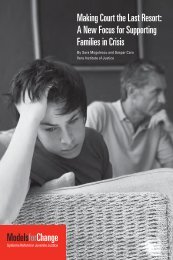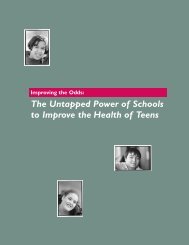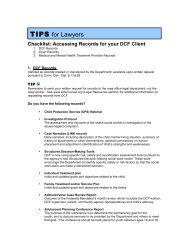Utility Access and Health - Center for Children's Advocacy
Utility Access and Health - Center for Children's Advocacy
Utility Access and Health - Center for Children's Advocacy
You also want an ePaper? Increase the reach of your titles
YUMPU automatically turns print PDFs into web optimized ePapers that Google loves.
The Energy Crisis <strong>and</strong> Its Impact onLow-Income Individuals & FamiliesConsider a blackout on a steamy summer afternoon. Inan instant, the lights go out, the air conditioner shutsoff, <strong>and</strong> the milk in the refrigerator starts to spoil. It’san unpleasant surprise, but at least the utility companyis working to get the power on as soon as they can.Yet <strong>for</strong> a growing number of Americans, utility companiesare actually doing the opposite ― they’re turningthe power off. With energy prices rising amidst a deeprecession, millions of people are falling behind onenergy bills. When the lights go out <strong>for</strong> these families,it’s not because of a downed power line; it’s becausethey can’t af<strong>for</strong>d to keep them on. 1Figure 1 2PRICE(Dollars per Thous<strong>and</strong> Cubic Feet)# of LettersU.S. Price of Natural Gas Delivered to Residential Consumer16141210864208001995 1996 1997 1998 1999 2000 2001 2002 2003 2004 2005 2006 2007 2008YEARWhen a household loses utility service, the potentialhealth consequences are severe <strong>and</strong> wide ranging. Coldweather can be a trigger to asthma, <strong>and</strong> low temperaturescan cause intense pain crises <strong>for</strong> childrenProtection Letters Written in BMC Pediatric Clinicwithsickle cell disease. 3 When family members who are700676chronically ill or disabled rely on refrigerated medicine600or electronic medical equipment in their homes, the500481risks during power outages are especially grave.400352Even 300 <strong>for</strong> low-income households that manage to paytheir 200 utility193bills, high energy costs often <strong>for</strong>ce familiesto 100 dig into their food budget, exposing them to othernegative 0 health outcomes. 4 Households in poverty2005-2006 2006-2007 2007-2008 2008-2009YEARoften sacrifice rent payments, medical <strong>and</strong> dental care,<strong>and</strong> food in order to pay their energy bills, which canconsume 16 to 25 percent of their annual income. 5“When families are <strong>for</strong>ced to make this ‘heat or eat’tradeoff, it’s a no win situation,” says Lauren Smith,Medical Director of the Massachusetts Department ofPublic <strong>Health</strong>. “You can’t give up a balanced diet orenergy access <strong>and</strong> expect to stay healthy, but <strong>for</strong> more<strong>and</strong> more families, there’s just not enough money topay <strong>for</strong> both.”While federal <strong>and</strong> state governments provide smallgrants to individuals <strong>and</strong> families at or below povertyguidelines through the low-income home energyassistance program (LIHEAP), only about 7.5 millionhouseholds, or one quarter of eligible householdsnationwide, received grants in 2009. 6The threat of utility shut-off confronts virtually all ofthe 24 million low-income households in the U.S. Fortyseven states offer some <strong>for</strong>m of utility shut-off protection7 , a guarantee of uninterrupted utility access <strong>for</strong>vulnerable individuals <strong>and</strong> families. Shut-off protectionrequires a doctor’s letter at specified intervals<strong>and</strong> varies drastically by state based on time of year,cold weather <strong>and</strong> illness. Shut-off protection ensurescontinued access to heat <strong>and</strong> electricity, but does noterase utility debt or reduce cost to the consumer.Shut-off protection programs vary greatly from stateto state. Alabama <strong>and</strong> Arizona have temperature basedrequirements, while Massachusetts <strong>and</strong> Washingtonoffer utilities protection only during certain monthsof the year. 8 Fewer than a dozen states have shut-offprotections in place during the summertime. Almost allstates offer shut-off protection <strong>for</strong> those with chronicserious illness, which must be verified by a letter froma medical provider, but each state has its own policy onhow often letters must be recertified so that familiescontinue receiving shut-off protection.
















